Culinary Mastery: Crafting Plum Jam with Delia Smith


Intro
In the world of preserves, few things bring the essence of summer into the cold months quite like a jar of homemade plum jam. This distinctive sweet and tangy treat not only serves as a delight on morning toast but carries with it a slice of history and culture. Delia Smith, a name synonymous with British cooking, has mastered the art of plum jam making, opening a portal to traditional culinary practices while embracing modern techniques.
Delving into Smith's methodology unveils a simple yet sophisticated process that transforms fresh plums into a delectable spread, perfect for enhancing a variety of dishes. This article will lead you through each step of crafting plum jam, illustrating why selecting the right plums is paramount and demonstrating the science behind achieving the coveted velvety consistency. Besides shares her insights into potential variations to delight any refined palate, this guide stands as a testament to the charm of homemade preserves.
As we journey through the nuances of jam-making, let’s relish the opportunity to bring this luscious creation into our own kitchens.
Foreword to Plum Jam
In the world of cooking, few things evoke nostalgia and warmth quite like a jar of homemade plum jam. This delightful preserve not only showcases the vibrant flavors of ripe plums but also plays a significant role in culinary traditions around the globe. Whether it's to enjoy with breakfast or as a sumptuous addition to desserts, plum jam offers both versatility and a touch of sweetness that enhances numerous dishes.
The Role of Jam in Culinary Traditions
Jam has held a cherished place in cuisines worldwide, going back centuries. It’s more than just a spread; it embodies the culture and history of food preservation. Historically, jams have been a practical way to extend the shelf life of fruits, allowing families to relish their bounty long after harvest. In various cultures, the process of making jam often becomes a communal activity, bringing people together to share recipes, stories, and the joy of creating something delicious.
Plum jam, in particular, bridges the gap between sweet and savory, often found at breakfast tables alongside cheeses, or as a filling in pastries. Its deep, rich hue reflects its robust flavor, making it a visually appealing addition to any dish. From the rustic settings of a farmhouse kitchen to the elegant dining spaces of fine restaurants, plum jam maintains its status as a beloved staple.
Why Choose Plum Jam?
Choosing plum jam for your culinary endeavors is not just about flavor; it's about connecting with tradition while also embracing creativity. Plums are juicy, sweet, and slightly tart, which results in a unique base for preserves. Their natural acidity balances the sweetness of added sugars, ensuring that the final product doesn't overwhelm the palate.
- Rich in Nutrients: Plums are packed with vitamins, antioxidants, and dietary fiber. Including plum jam in your diet can provide health benefits alongside enjoyment.
- Versatile Usage: Beyond just spreading on a slice of bread, plum jam can enhance various dishes. It can be used to glaze meats, stir into yogurt, or sweeten sauces.
- Culinary Exploration: Making plum jam offers a gateway to experimenting with flavors. You can infuse it with spices like cinnamon or cardamom, or even mix it with other fruits, leading to exciting variations.
Furthermore, the very act of making plum jam can be immensely satisfying. It connects you to the seasons, emphasizes the importance of fresh ingredients, and makes you part of a long-standing tradition that spans generations. All these elements make plum jam an enticing choice for anyone looking to deepen their culinary repertoire.
Overview of Delia Smith's Culinary Philosophy
Delia Smith has long held a significant place in the hearts of food enthusiasts and home cooks alike. Her culinary philosophy centers around a few key concepts: simplicity, reliability, and an underlying respect for ingredients. This section delves into the foundational ideas that shape her approach, which is particularly relevant when it comes to making plum jam.
The essence of her methodology is not just about creating habitable recipes, but about empowering cooks to feel confident, no matter their skill level. When people talk about her, there’s a common thread about how she makes cooking feel accessible and achievable—her recipes act like a guiding star through the sometimes overwhelming world of culinary arts. Having such a philosophy underscores the importance of each step in making plum jam, from selecting the fruit to the final jar on the shelf, ensuring that every cook can participate in this treasured practice.
A Legacy in British Cooking
Delia Smith’s legacy in British cooking can hardly be overstated. She’s a household name, not merely because of her cookbooks or television shows, but due to her ability to transform the perception of home cooking. In her book "Delia’s Complete Cookery Course," for instance, she demystifies the art of cooking, and this ease extends to the world of preserves.
Her work resonates across generations, breeding a sense of nostalgia and connection to the British culinary landscape. When plum jam is the topic at hand, Smith’s influence is felt in kitchens throughout the UK. She stresses the importance of technique while advocating for the right ingredients. This means understanding what makes different varieties of plums shine and how their inherent characteristics can contribute to the overall quality of the jam. Through her teaching, the craft of jam-making becomes less of an art and more a cherished tradition that can be learned and passed down.
Her Approach to Preserving Fruits
Delia's approach to preserving fruits is methodical yet straightforward. She emphasizes the importance of quality over quantity, ensuring that each jar of jam captures not just flavor, but also the essence of the fruit.
In her recipes, Delia makes a strong case for using seasonal plums, which provide a richer, more robust flavor profile. She teaches cooks how to prioritize freshness—something that is often overlooked in the rush of modern cooking. This aspect of her philosophy extends to understanding acidity, sweetness, and pectin content, factors that deeply influence the final outcome of jams and preserves.
Her straightforward instructions promote a sensory relationship with cooking, urging cooks to trust their instincts and taste as they go. This element is especially vital in jam-making, where the line between success and failure can hinge on the smallest details. Through her guidance, aspiring home cooks not only create delicious plum jam but also cultivate a broader understanding of fruit preservation that can lead to endless culinary possibilities.
"Cooking isn’t about perfection; it’s about participation and enjoyment—embracing the process can yield incredible results."
In essence, exploring Delia Smith's culinary philosophy offers aspiring jam-makers a comprehensive arsenal of techniques paired with the confidence needed to inspire creativity in their own kitchens.
Ingredients for Delia Smith's Plum Jam
The essence of a well-crafted plum jam lies not just in the cooking method, but heavily in the sheer quality and selection of ingredients. When following Delia Smith's methodology, you are guided by her philosophy, which emphasizes the importance of fresh, seasonal components. Each ingredient plays a critical role, affecting the flavor, texture, and overall outcome. This section serves as a roadmap to understanding what goes into a superior plum jam, ensuring that every bite reflects both care and craftsmanship.
Selecting the Right Plums
Varieties to Consider
In the realm of plums, the choice of variety can make or break a jam. Common ones like Victoria, Greengage, and Damson each possess distinct characteristics that influence taste and texture. For instance, Victoria plums are revered for their sweet flavor and relatively high pectin content, making them a favorite among jelly enthusiasts. On the other hand, Damsons tend to pack a tart punch and offer a rich color, which can enhance the aesthetic appeal of the jam.
Each type brings its own unique twist to the recipe. When selecting, consider that taste preference is subjective; some might savor the sweetness of a ripe Victoria, while others may lean towards the sharpness of a Damson. It's a dance of flavors that captures the essence of the fruit. However, it's crucial to balance sweetness with acidity — an element that not only contributes to flavor but also aids in the preservation process.
Seasonality of Plums
Timing is everything, especially when it comes to choosing plums for your jam. The best plums often come into season from late summer to early autumn, depending on your location. Seasonality impacts flavor, as plums harvested at their peak ripeness are typically sweeter and juicier, enhancing the overall quality of your jam.
Buying out of season results in less flavorful fruit, which can lead to a subpar jam experience. Plus, fresh fruit supports the local economy and reduces the carbon footprint associated with transportation. Therefore, sticking to the seasons not only ensures better taste but aligns with sustainable practices. Check local farmers' markets around late summer for the juiciest and most flavorful plums.
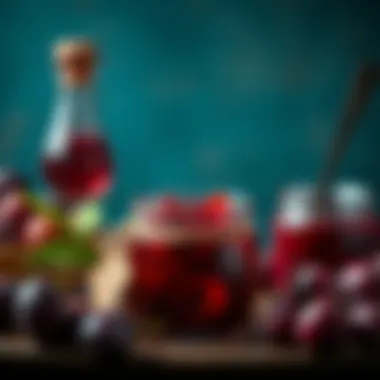

Additional Ingredients Required
Sugar Types
Sugar is far more than just a sweetener in jam-making; it acts as a preservative and helps achieve that coveted gel-like consistency. In Delia’s plum jam recipe, the kind of sugar you choose matters tremendously. White granulated sugar is a go-to for its neutral flavor and reliable gelling properties. However, using brown sugar can lend a deeper, caramelized taste, enhancing the overall flavor profile.
There's also specialty sugars like muscovado, which has a rich molasses flavor, and could be a delightful twist if you're looking for something a bit different. When experimenting with sugar types, keep in mind that it may affect the jam’s color and texture. Too much sugar can lead to overly thick jam, while too little can prevent proper setting.
Optional Flavor Enhancers
While plum jam shines on its own, there's nothing wrong with adding flair through optional flavor enhancers. Ingredients such as fresh lemon juice, or a dash of vanilla extract, can elevate the jam to another level. The acidity of lemon not only balances sweetness but also brings brightness to the flavor.
Experimenting with spices like cinnamon or even a splash of port wine can introduce warmth or complexity. However, it's vital to use these enhancers sparingly; the goal is to complement the plums, not overshadow them. The beauty of optional flavorings lies in their potential for customization, allowing home chefs to truly infuse their personality into their jam.
"The joy of making jam lies in the exploration of flavors; it's where tradition meets innovation."
Understanding the ingredients required for Delia Smith's plum jam lays the groundwork for achieving culinary excellence. Choosing the right fruits, sugars, and flavorings together opens the door to a jam that is not only delicious but also reflects a depth of flavor and creativity.
Step-by-Step Method of Making Plum Jam
The process of making plum jam is moved from mere cooking to an art form through a precise method, deeply rooted in both science and culinary tradition. Delia Smith’s approach spells out each step, ensuring that even the novice cook can create a delightful preserve. Focus on the method not only provides clarity; it also guarantees the end result is both palatable and texturally satisfying. Mastering each step paves the way for a rewarding jam-making experience, bridging the gap between theoretical understanding and practical application.
Preparing the Plums
Washing and Pitting
Washing the plums may seem like a no-brainer, but it’s a critical first step that sets the stage for your jam-making endeavor. Rinsing the plums under cool, running water not only removes dirt but also any pesticides that might linger on the skins. It’s the kind of meticulous attention to detail that Delia promotes in her methodology. Once washed, pitting the plums is your next task—this involves removing the stone from each plum. Not only does this prevent a bitter taste from the stones, but it also ensures a smoother consistency in your jam.
The unique advantage of washing and pitting is that it directly influences the flavor and quality of the finished product. Failure to do either effectively can spoil your efforts, leading to an unsatisfactory final product. While some people may find pitting a bit of a chore, the rewards are plentiful.
Chopping Techniques
Chopping the plums into uniform pieces plays a major role in achieving a consistent texture. It’s more than just slicing fruit; it’s about understanding how size affects cooking times. For instance, larger chunks will take longer to break down, possibly leading to uneven sets in your jam. A favorite method is to quarter the plums, which balances size and surface area—providing ample fruit to jam ratio while ensuring even cooking.
Moreover, this technique allows for a delightful burst of flavor in each spoonful. The beauty of chopping lies not only in the mechanics but in how you choose to handle the fruit. When the pieces are harmonious in size, you’re bound to achieve that perfect viscosity and mouthfeel that is quintessential for any fruit preserve.
Cooking Process Explained
Key Temperatures
Temperature control during the cooking process cannot be overstated. For plum jam, reaching the right temperature is crucial for achieving that gelled consistency. Typically, you’ll want to bring the mixture to a rolling boil until it hits about 220°F (104°C). This temperature activates pectin within the fruit, setting the stage for the thickening process.
If you don’t reach that magic number, your jam will remain runny—like syrup, rather than luscious spread. The importance of precision in this stage cannot be overlooked; it’s a testament to why Delia’s methods resonate with so many home cooks who wish to replicate her success.
Stirring Guidelines
Just as important as cooking temperature are the stirring techniques employed during the jam-making process. Stirring gently but consistently helps to distribute the heat evenly, preventing certain areas from sticking to the pan. This is particularly important as sugars caramelize quickly, which can lead to undesirable burnt flavors in your jam.
One practical guideline is to use a wooden spoon. It allows for better control and a more tactile feedback as you gauge the thickness of the mixture. This technique not only aids in achieving the right consistency but also enhances the jam's flavor profile, ensuring the ingredients meld beautifully.
Testing for Setting Point
Testing for the setting point is a pivotal part of making plum jam successfully. This process involves checking if the mixture has reached the correct consistency for jarring. One popular method is the plate test—scooping a bit of jam onto a cold plate and letting it sit for a moment. After a little time, you should push it with your finger, and if it holds its shape without rapidly running back together, you’ve reached the setting point. This step is crucial to ensure you are not left with a runny jam that spreads lame on toast.
Jarring and Storage Techniques
Sanitizing Jars
Sanitizing jars is a necessary part of the process, protecting the jam from unwanted bacteria and spoilage. You can achieve this by washing jars in hot, soapy water, then placing them in a hot oven for about ten minutes or by using boiling water. The idea is to eliminate any contaminants that could interfere with the preserving process.
Using sanitized jars extends the shelf life of the jam significantly; if they’re not properly sanitized, you'll risk spoilage and waste, which—let’s face it—is in no one’s interest.
Sealing Methods
The readied jam must be appropriately sealed to ensure it stays fresh for months. Common techniques involve the use of both traditional metal lids and wax seals. The lid method often includes a vacuum seal that is created as the jar cools. If done correctly, it will produce a satisfying pop sound, indicating that your jar is sealed tight.
Choosing the right sealing method is crucial to maintain the jam's flavors and prevent issues such as oxidation. Thus, following guidelines closely as outlined in Delia’s recipes is imperative for success.
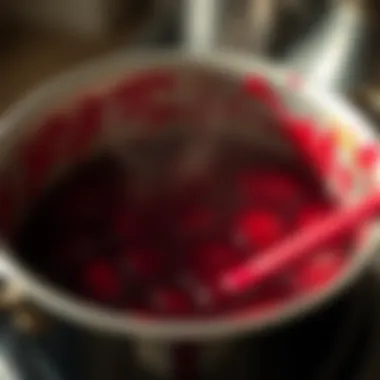
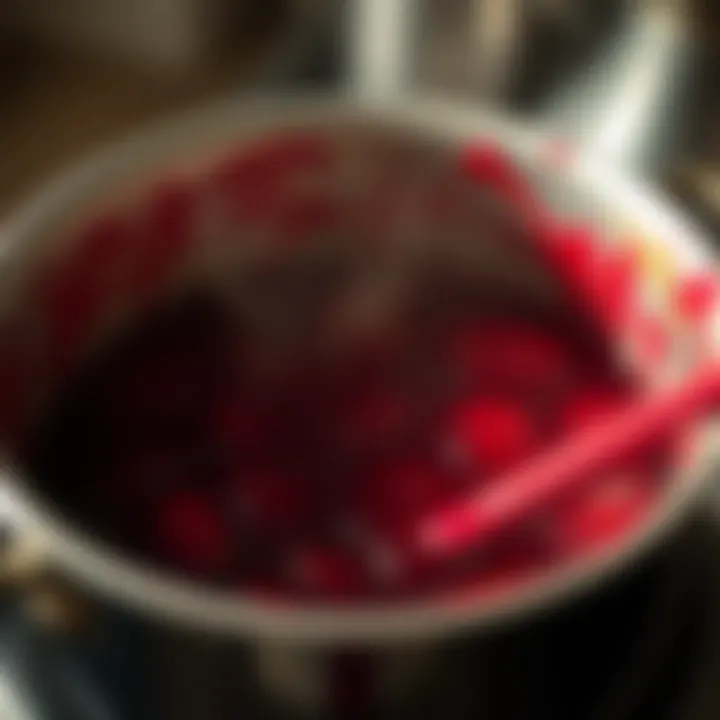
Remember, properity in jam-making takes patience and precision!
Common Challenges in Jam-Making
Creating plum jam, while seemingly straightforward, is fraught with various challenges that can either make or break your final product. This section dives into the common hurdles faced during the jam-making process. Understanding these challenges helps aspiring jam makers achieve success and produce a delectable result. From achieving the right consistency to maintaining vibrant color and flavor, mastering these aspects of jam-making is essential.
Preventing Undersetting
When making jam, achieving the right set is one of the most crucial steps. Undersetting occurs when the jam fails to reach a proper consistency, leading to a runny product that can’t hold its form. This can be particularly disappointing after the long process of preparation and cooking.
To prevent this issue, it’s important to understand the role of pectin. Pectin is a natural thickener found in fruits, and not all plums have the same pectin content. If the plums you selected are low in pectin, consider adding a bit of apple or using commercial pectin. Additionally, make sure to cook the mixture long enough to allow for evaporation of excess water; too short of a cooking time can lead to undercooked jam. A simple test for setting point involves placing a spoonful of hot jam on a chilled plate and tilting it. If it holds its shape, you’re good to go!
Avoiding Overcooking
On the flip side, overcooking your jam can lead to a sticky mess that has lost both flavor and color. Overcooked jam becomes overly thick and can taste burnt, robbing your creation of its natural fruitiness.
To avoid this pitfall, keep a close eye on the temperature while cooking. Using a candy thermometer can help monitor the cooking process closely. The recommended temperature for jam typically hovers around 220°F (104°C). Stir the mixture steadily but gently, as the fruit particles need to circulate evenly, ensuring an even cook. If you notice the jam beginning to darken too quickly, reduce the heat. Remember, it’s much easier to adjust and recook than it is to fix an already overcooked batch!
Troubleshooting Color and Flavor Issues
As you embark on your jam-making journey, you may encounter color and flavor inconsistencies that can be disappointing. Plum jam should ideally showcase a rich, deep hue, along with the sweet-tart tang characteristic of ripe plums. Sometimes, you may find your jam leaning towards a less appealing shade or lacking the bright flavor you expected.
This often stems from the balance of ingredients used. When making plum jam, always taste as you go along. Adjust the sweetness and acidity by adding a splash of lemon juice or a bit more sugar. If the color appears dull, this could indicate that the jam has been cooked too long or at too high a temperature. To brighten things up, incorporating a small amount of fresh plum puree during the final stages of cooking can enhance both color and flavor. Remember, the overall appeal is not just about taste—it's about the visual aspect as well.
Cooking is a delicate dance between science and art; being mindful of how each element affects the outcome ensures a delicious and vibrant jam.
By recognizing these common challenges and their nuances, you can navigate jam-making like a pro. Each hurdle offers an opportunity to learn, adapt, and create a truly standout plum jam that packs a punch on any breakfast table.
Enhancing Your Plum Jam
Enhancing your plum jam isn't just a culinary twist; it’s a way to elevate a beloved classic into something truly special. This section focuses on techniques that allow home cooks to personalize their jam, ensuring that every jar reflects not only the rich flavor of plums but also the creative spirit of its maker. By incorporating other fruits and experimenting with spices or extracts, you can create a jam that is uniquely yours and perhaps even a talking point for guests.
Incorporating Other Fruits
One of the most effective ways to enhance your plum jam is by adding other fruits. Mixing flavors can introduce a new dimension that makes the jam more complex and enjoyable. Here are some common companions to plums that can transform your jam:
- Peaches: Their sweetness pairs beautifully with the tartness of plums, leading to a well-rounded flavor.
- Cherries: A classic mixture, the two fruits blend seamlessly, and they offer wonderful color contrasts.
- Lemons: Just a touch can add acidity, enhancing the overall freshness.
Consider the balance between sweet and tart fruits. Using fruits like cranberries can impart a sharpness that complements the sweetness of plums. However, it’s crucial to maintain a balance so that the distinctive plum flavor remains the star.
Experimenting with Spices and Extracts
Spices and extracts play significant roles in flavor enhancement, offering a bouquet of possibilities that can turn a simple plum jam into a gourmet delight. Some choices to consider include:
- Cinnamon: A warm spice that adds depth, perfect for fall or winter recipes.
- Vanilla Extract: Just a splash can give your jam a silky, smooth flavor that speaks to indulgence.
- Ginger: Fresh or powdered, it adds a kick that can be surprisingly delightful when paired with plums.
It's important to approach spices thoughtfully. Start with small amounts and taste as you go; the goal is to complement the plums, not to overwhelm their natural flavor.
"The best culinary creations often stem from a willingness to experiment and a keen understanding of balance."
Enhancing your plum jam allows for a personalized touch that reflects both tradition and creativity. The process is not just about preserving fruit; it’s about crafting something memorable, a jar brimming with flavors that can transport you back to summer days or evoke the coziness of a winter afternoon. Don't shy away from making it your own; the kitchen is your canvas!
Serving Suggestions for Plum Jam
Serving suggestions for plum jam play a pivotal role in enhancing its enjoyment and integrating it into various culinary experiences. Beyond simply spreading it on toast, plum jam offers a world of possibilities. This section delves into how to elevate the humble jam into a gourmet addition to various dishes, tantalizing taste buds and showing off culinary creativity.
Pairing with Bread and Pastries
When it comes to bread and pastries, plum jam stands tall and proud as a top choice. Its rich, fruity flavor complements different types of dough beautifully. Consider these popular pairings:
- Sourdough Bread: The tangy notes of sourdough often create a delightful contrast with the sweet and tart flavor of plum jam. A slice toasted to perfection, spread thick with jam, is a breakfast staple in many homes.
- Croissants: Light, flaky croissants filled with plum jam can easily transform a regular brunch into an extraordinary affair. Their buttery texture pairs with the jam perfectly, delivering an indulgent experience.
- English Muffins: The nooks and crannies of an English muffin hold the sweet and sticky goodness of jam in each bite, making it an ideal vehicle for plums. Add a dollop of cream cheese for a delightful twist.
These pairings not only enhance the flavor of the bread but create a sensory experience that lingers.
Creative Uses in Desserts
Plum jam isn’t limited to being simply a spread; it also shines as an ingredient in a variety of desserts. Below are a few intriguing uses:
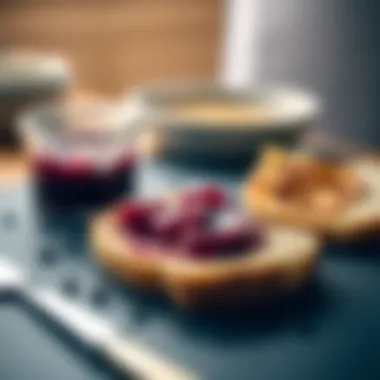
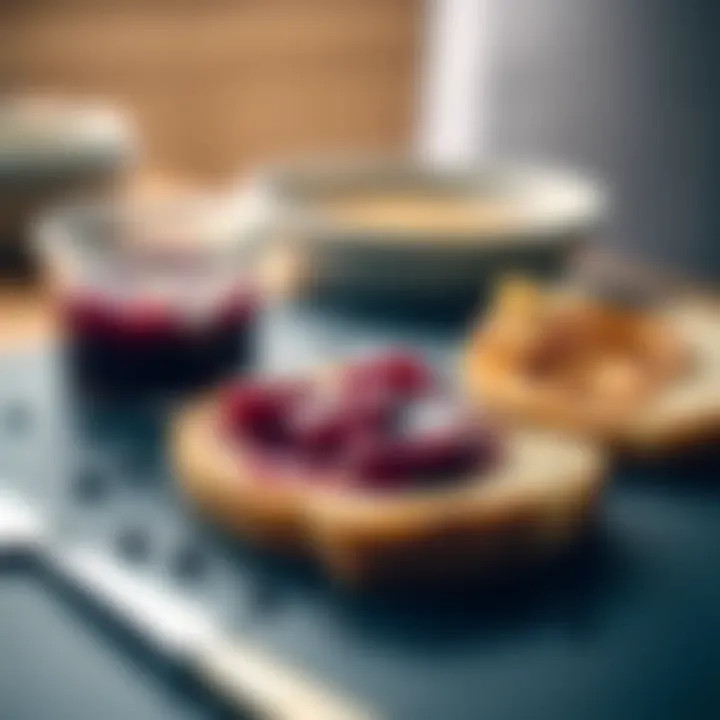
- Layered Cakes: Incorporating plum jam between layers of vanilla or chocolate cake adds a fruity burst of flavor. It keeps the cake moist and provides visual appeal with its rich color.
- Pavlova Topping: For a rich yet light dessert, top a meringue dome with whipped cream and generous spoonfuls of plum jam. The vibrant color and flavor will wow your guests.
- Ice Cream Swirl: Mix plum jam into homemade ice cream before freezing it. The swirls of intense flavor will create an eye-catching and delicious treat.
Plum jam’s versatility in desserts can inspire a range of culinary creations that will surprise and satisfy sweet-toothed diners.
"Food should be fun, and with plum jam, it can be an adventure that elevates every meal!"
These suggestions serve not only to offer ideas but also to ignite the imagination of food lovers everywhere, showcasing how one jar of jam can transform meals into memorable moments. In the realm of flavor, the possibilities are endless.
Nutritional Aspects of Plum Jam
Understanding the nutritional profile of plum jam is essential for those looking to enjoy this delicious preserve while considering their dietary needs. With the rich flavors and vibrant colors of plum jam, it’s tempting to overlook its contributions to a balanced diet. However, as health consciousness rises, knowing the caloric content and health benefits of plums can enhance one's appreciation of this classic spread.
Caloric Content Analysis
When delving into the caloric breakdown of plum jam, it’s important to note that the sweetness and rich flavor come at a cost. Generally, a typical serving of plum jam—roughly one tablespoon—contains approximately 50 calories. This is largely from the sugar content, primarily used as both a preservative and a sweetener.
- Sugar Content: A single tablespoon can contain around 13-14 grams of sugar. This points to the fact that enjoying plum jam in moderation is key, especially for those tracking their sugar intake.
- Energy Source: While it does provide quick energy due to its sugar content, the lack of fiber and higher glycemic index means it should be balanced with other nutritious foods.
- Nutritional Balance: While plum jam does not hold a high caloric value, it can easily add up if enjoyed generously on toast or pastries. Making mindful choices about portion sizes can help manage overall caloric intake while indulging in this delightful spread.
Health Benefits of Plums
Plums themselves are packed with beneficial nutrients that contribute to overall health, and thus, plum jam can retain some of these valuable aspects. Here are a few noteworthy points about the health benefits of plums that can carry over to the jam:
- Vitamins and Minerals: Plums are a good source of vitamin C, vitamin K, and potassium. Vitamin C plays a crucial role in supporting the immune system, while potassium helps regulate blood pressure.
- Antioxidants: They are rich in antioxidants like anthocyanins, known for their anti-inflammatory properties. These compounds can aid in reducing the risk of chronic diseases.
- Digestive Health: Although the fiber content decreases with the cooking process, plums still possess some digestive benefits. The pectin found in plums aids in bowel regularity.
"In moderation, plum jam offers a touch of sweetness to foods while still delivering nutritional benefits derived from the plums themselves."
- Low Glycemic Index: When paired with whole grains, like whole grain bread or oats, plum jam can complement a meal without spiking blood sugar levels excessively.
- Mood Booster: The burst of sweetness from plum jam can also act as a comfort food, providing that little lift needed during a weary day, though it’s wise to remain aware of balancing it with nutrient-dense foods.
Cultural and Historical Context of Plum Jam
Exploring the cultural and historical context of plum jam is essential, as it provides a deeper understanding of its significance within culinary traditions. Jam-making isn't just about preserving fruit; it's a reflection of community, resourcefulness, and heritage. In the case of plum jam, it embodies centuries of practices handed down through generations, illustrating the importance of not wasting seasonal abundance. What may seem like a simple fruit spread can narrate stories of survival, social gatherings, and even celebrations.
Historical Significance of Jam-Making in Britain
Jam-making in Britain has a storied history, with roots that stretch back to medieval times when sugar was considered a luxury. Initially, it was the wealthy who enjoyed fruits preserved in syrup, a practice that soon trickled down to the common folk. By the 18th century, preserving fruits became essential; the availability of sugar and the advent of canning methods made it more accessible to everyone.
- In rural communities, making jam was both a necessity and a way to bond. Neighbors would gather to share their fruits, share techniques, and share a good laugh, weaving community ties.
- The establishment of large-scale fruit cultivation transformed Britain’s agricultural landscape, with plums becoming one of the favored fruits for preserves.
- Over time, recipes flourished, leading to regional variations in jam-making, reflecting personal touches and local ingredients.
This traditional process highlights not just culinary skill, but also a rich tapestry of social history and evolution. The annual ritual of jam-making conveys a sense of continuity, linking the past with the present.
Plum Jam in Different Cultures
Across the globe, the practice of making jams, including plum jam, varies significantly from culture to culture. Each region boasts its own unique take on the preserve, flavored by local customs, fruits, and palates.
- In Eastern Europe, plum jam is a staple. Countries such as Hungary and Romania create dense, richly flavored jams that often find their way into pastries or enjoy a place on the breakfast table.
- In China, various plum varieties are transformed into sweet and sour sauces that serve as dipping condiments, showcasing how the fruit transcends simple preserve status.
- In the Southern United States, where plums are abundant, jam-making is often intertwined with church socials and family reunions, acting as a bridge between generations.
Emphasizing these varied approaches helps illuminate how cultures adapt and innovate, making plum jam a delightful and diverse accompaniment that resonates far beyond its sweetness. It’s a peek into how ingredients, when thoughtfully preserved, can reflect and celebrate heritage across different tables around the world.
"Food is not just sustenance; it is a vessel of culture, history, and tradition, passed down through generations."
By examining the cultural and historical context of plum jam, readers can truly appreciate its place not just on their toast, but in the fabric of culinary history.
The End
In wrapping up this exploration of Delia Smith's plum jam recipe, it's important to acknowledge several key elements that emerge throughout the article. The rich tapestry of culinary artistry woven through the age-old tradition of jam-making not only connects us to our food history but also empowers home cooks to experiment and innovate. Delia’s method showcases how simple ingredients can transform into complex flavors, making it essential for anyone interested in enhancing their culinary repertoire.
The benefits of making plum jam extend far beyond the finished product. From the satisfaction of creating something with your own hands to understanding the preservation process, each aspect brings personal joy. The care involved in selecting the right plums, mastering the cooking techniques, and even troubleshooting common pitfalls culminates in a marvelously tasty jam that reflects one’s personality and taste.
Additionally, there’s merit in the ritual of making preserves; it is a process steeped in nostalgia and creativity. Every spoonful can evoke memories of sun-drenched orchards or cozy kitchen gatherings. Thus, for anyone looking to indulge in the joys of culinary craftsmanship, making plum jam is a delightful entry point into the world of preserving fruits.
"Culinary masterpieces begin with simple ingredients aligned with heartfelt intent."
As we conclude, consider that this jam-making journey encapsulates more than just a recipe; it captures the essence of what home cooking represents—connection, creativity, and joy. Therefore, keep this methodology in mind as you venture into crafting your very own pots of plum jam.
Recap of Key Takeaways
- Delia Smith’s methodology offers a structured approach to making plum jam, balancing tradition with modern techniques.
- Select ripe, high-quality plums for the best flavor.
- Follow precise cooking guidelines to achieve the perfect consistency and prevent common pitfalls.
- Remember the joy of experimenting with flavors, enhancing your jam with spices or other fruits.
Encouragement to Try Making Plum Jam
Diving into the practical side of cooking can feel daunting, but making plum jam is both approachable and gratifying. There’s no need for culinary expertise to start this journey. Simply gather a few ripe plums, some sugar, and a large pot, and you’re good to go. Even if your first attempt doesn’t turn out picture-perfect, it’ll still be a tasty treat! Experience this culinary rite of passage; adorn your toast, complement a cheese platter, or find creative uses in your desserts with your homemade jam.
In the grand midst of culinary adventures, a jar of plum jam can become a memorable addition to your kitchen. So why not roll up your sleeves and embark on this flavorful journey today? The experience not only promises a delectable outcome but also a newfound appreciation for the art of preserving—one sweet batch at a time.
For more inspiration on homemade preserves, check out resources such as en.wikipedia.org or britannica.com.















